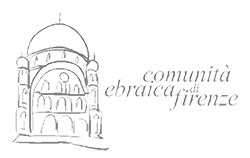THE
MUSEUM
The design of the Jewish Museum in Florence, strongly backed by Rabbi Fernando Belgrado, was initiated in 1981 as a result of the donation of Marta del Mar Bigiavi. The first exhibit occupied the first floor in a room behind the women’s gallery and included the historical section and the furniture and home furnishings of synagogue worship. The project was designed by the architect Alberto Boralevi, with the exhibition design by Dora Smooth. The second part of the museum, opened in 2007, is located on the top floor, and was designed by the architect Renzo Funaro in collaboration with the architect Michael Tarroni and was set up by Dora Smooth and for the textile industry section by Laura Zaccagnini. This time the museum was divided into two sections: the first floor were the furnishings ceremonial use in the synagogue, in the latter have been moved to objects for domestic worship.
One room, curated by Renzo Funaro and Liana Funaro, was dedicated to the Holocaust.
The choice of rooms and Museum set up has been done based on museological and conservation considerations. First, it was decided to set it in the Temple which, due to its artistic and historical importance for its monumentality, not only represents the ideal, but it has become an integral part of the course of Jewish History in Florence. The cellars, while beautiful and impressive, but who did not have security policies because of the danger of floods (the last of which, in 1966, came up to two meters in height above the height difference created by the steps outside), have been discarded. It is a relatively small museum, but very impressive.
The collections of the Jewish Museum in Florence are arranged on two floors inside the synagogue.
The first section documents the history of the Jews in Florence over the centuries and their relationship with the city. In the display cases are furniture, textile, and silver, used for ceremonies synagogue between the end of the sixteenth and nineteenth centuries. On the second floor, in a room with a beautiful view on the inside of the temple, there are objects and furnishings of domestic and private devotion, illustrating the highlights of the festivities and religious life of a Jew such as birth, marriage and religious ceremonies. Many of these items are gifts from Jewish families who wanted to testify so their attachment to the Community. Important figures in the community in the knight David Levi, who left his fortune to construct the building of the synagogue, and that of Rabbi Shmuel Zvi Margulies, of Polish origin, who renewed the Italian Rabbinical College and brought it to Florence.
The tour continues with a film that introduces the history of the community in the past two centuries, and a room of Remembrance, where photos and archival records of the life of the Jews in Florence, the newfound equality after the age of ghettos, persecution, to following the racial laws, and deportation to the death camps, to the rebirth and reconstruction after the war, are displayed. A computer room connected to the major Jewish museums in the world and puts the Florentine Jewish life in a very broad context.
The museum consists of a first section, which documents the history of the Jewish Florentine by birth, in 1437, at the time of the founding of the Ghetto, its extension in 1571, and again from 1704 to 1721, until the demolition of the last decade the nineteenth century. This is illustrated through photographs of plants, pictures of the ghetto destroyed and ancient synagogues. Newer images illustrate the story of the design and construction of the Temple. There is also a nod to the other sites of Jewish Florence.
Most of the furnishings are from two synagogues in the Ghetto, that the Italians opened after the creation of the district intended to house arrest by the Jews in 1571, and the Spanish and Levantine, opened a few years later, which objects were added that belonged to the synagogues of Arezzo and Lippiano -communities that are now extinct- and by the synagogue, for which they were specially made. Considerable space is devoted to the ornaments of the Sefer Torah, the scrolls of parchment on which the Hebrew bible is written.
The second part of the museum, opened on the top floor in 2007, is a collection of objects and drawings that summarize the origins of the Jewish community in Florence.
If the Chevalier David Levi is the symbol for excellence of Italian Jewry (illustrated in “the Italian,” a beautiful portrait by Antonio Ciseri in 1854), the core of most influential Jews were of Sephardic origin, originating in Spain, subsequently, the countries of North Africa and the Middle East. Here you can view significant objects that illustrate the most important moments of life and religious holidays, with personal or household furnishings organized by type and according to different occasions. The family has a very important role in the Jewish religion. Most of the six hundred commandments (mitzvot), that every jew is obliged to follow, are put into practice in daily life. Many of the exhibits in the museum follows the story of an important Florentine family, the Ambron-Errera family, whose history can be witnessed here.

